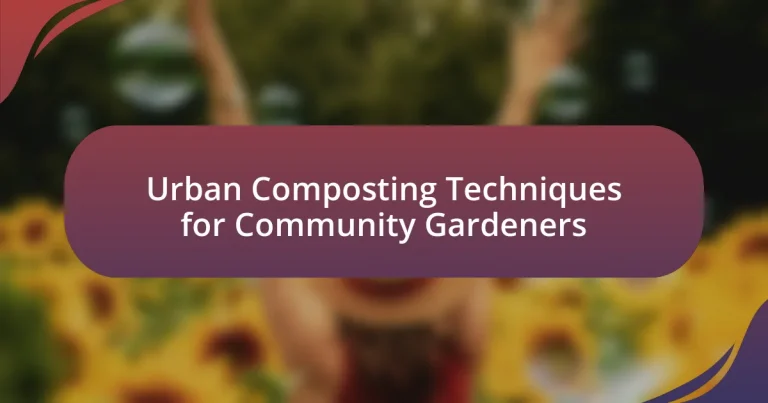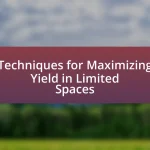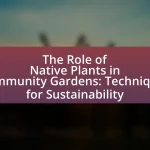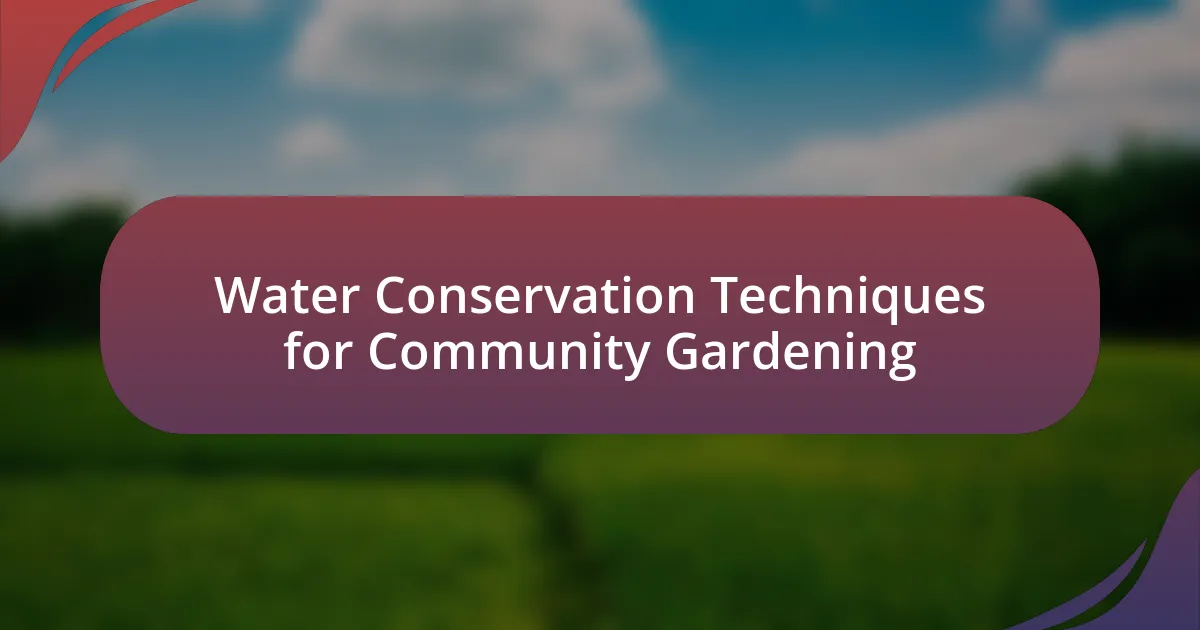Urban composting techniques for community gardeners encompass methods such as vermicomposting, bokashi composting, and traditional composting, each tailored for limited urban spaces. These techniques address challenges like space constraints, regulatory restrictions, and contamination risks while promoting sustainable gardening practices. The article explores how urban environments influence composting methods, the environmental benefits of composting, and the importance of community engagement. Additionally, it provides practical tips for effective compost management, including material selection, moisture control, and aeration, ensuring that community gardeners can successfully enrich their soil and reduce waste.
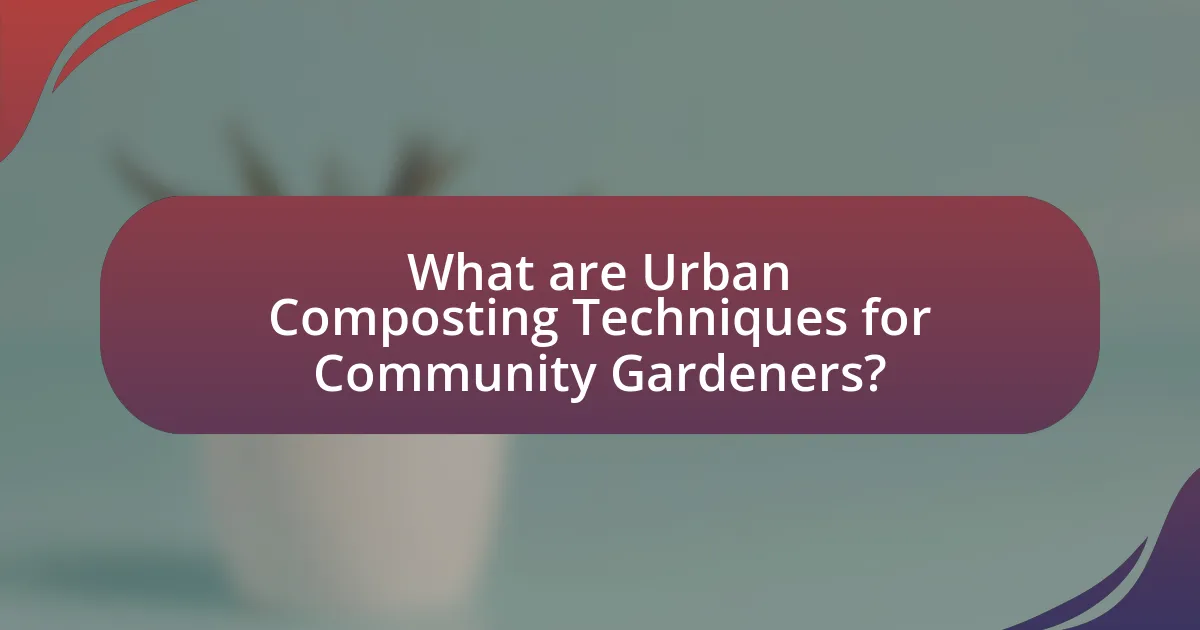
What are Urban Composting Techniques for Community Gardeners?
Urban composting techniques for community gardeners include methods such as vermicomposting, bokashi composting, and traditional composting. Vermicomposting utilizes earthworms to break down organic waste, producing nutrient-rich compost in a compact space, making it ideal for urban settings. Bokashi composting involves fermenting organic waste using a specific mix of microorganisms, allowing for quick decomposition and minimal odor, suitable for small areas. Traditional composting, which involves layering green and brown materials in a compost bin or pile, can also be adapted for urban environments by using smaller bins or tumblers to accelerate the process. These techniques are effective in reducing waste and enriching soil, contributing to sustainable urban gardening practices.
How do urban composting techniques differ from traditional composting?
Urban composting techniques differ from traditional composting primarily in scale and method. Urban composting often utilizes smaller, more contained systems such as worm bins or bokashi fermentation, which are suitable for limited space and can process food waste quickly. In contrast, traditional composting typically involves larger piles or bins that require more space and time for decomposition, relying on natural aerobic processes. Urban composting also frequently incorporates community engagement, allowing residents to collectively manage waste, whereas traditional composting is often an individual or household effort. These differences are essential for adapting composting practices to urban environments, where space and community involvement are critical factors.
What specific challenges do community gardeners face in urban composting?
Community gardeners face several specific challenges in urban composting, including limited space, regulatory restrictions, and contamination risks. Limited space in urban environments often restricts the size and number of compost bins that can be utilized, making it difficult to manage organic waste effectively. Regulatory restrictions, such as local ordinances regarding composting practices, can hinder the establishment of composting systems. Additionally, contamination risks arise from improper materials being added to compost, which can lead to odors and pests, further complicating the composting process. These challenges are documented in studies highlighting the complexities of urban gardening and composting practices.
How can urban environments influence composting methods?
Urban environments influence composting methods by necessitating adaptations to limited space, diverse waste streams, and regulatory frameworks. In densely populated areas, community composting initiatives often utilize vertical composting systems or worm bins to maximize efficiency in small spaces. Additionally, urban composting must address a variety of organic materials, including food scraps from restaurants and households, which can lead to the development of specialized composting techniques that accommodate different waste types. Furthermore, local regulations may dictate composting practices, such as restrictions on certain materials or requirements for odor control, thereby shaping the methods employed by urban gardeners.
Why is urban composting important for community gardens?
Urban composting is important for community gardens because it provides a sustainable source of nutrient-rich soil amendments that enhance plant growth. By recycling organic waste, community gardens can improve soil health, increase biodiversity, and reduce the need for chemical fertilizers. Studies show that composting can increase soil organic matter by 5-10%, which significantly boosts soil fertility and water retention. Additionally, urban composting fosters community engagement and education, as residents learn about waste reduction and sustainable practices while participating in the gardening process.
What environmental benefits does urban composting provide?
Urban composting provides significant environmental benefits, including reducing landfill waste and enhancing soil health. By diverting organic waste from landfills, urban composting decreases methane emissions, a potent greenhouse gas produced during decomposition in anaerobic conditions. Additionally, compost enriches soil by improving its structure, moisture retention, and nutrient content, which promotes healthier plant growth and reduces the need for chemical fertilizers. Studies indicate that compost can increase soil organic matter by 5-10%, leading to improved biodiversity and ecosystem resilience.
How does urban composting contribute to community engagement?
Urban composting fosters community engagement by creating opportunities for collaboration and education among residents. Community members participate in composting initiatives, which encourages teamwork and shared responsibility for waste management. Research indicates that neighborhoods with active composting programs report increased social interactions and a stronger sense of community identity. For example, a study by the University of California found that community composting projects led to a 30% increase in local volunteerism and participation in other community activities, demonstrating the positive impact of composting on community cohesion.
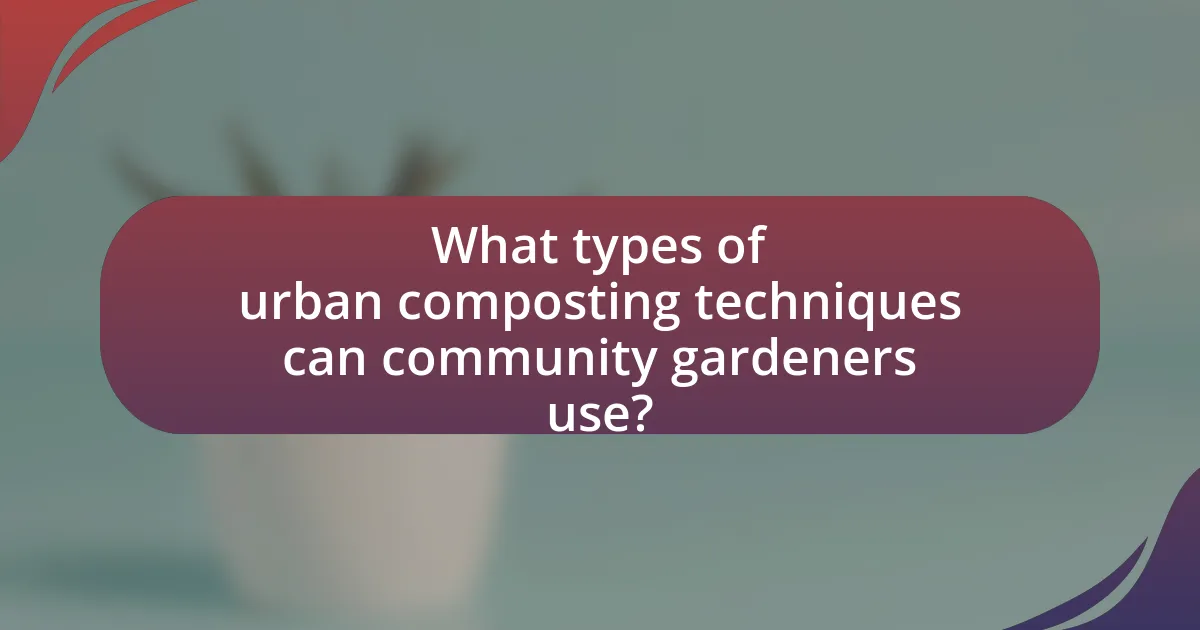
What types of urban composting techniques can community gardeners use?
Community gardeners can use several urban composting techniques, including traditional composting, vermicomposting, bokashi composting, and trench composting. Traditional composting involves creating a compost pile or bin where organic waste decomposes over time, typically requiring a mix of green and brown materials. Vermicomposting utilizes worms to break down organic matter, producing nutrient-rich worm castings. Bokashi composting is an anaerobic process that ferments food waste using specific microorganisms, allowing for quick decomposition. Trench composting involves burying organic waste directly in the soil, where it decomposes and enriches the earth. Each technique is suitable for urban environments and can effectively reduce waste while enhancing soil quality.
How does vermicomposting work in urban settings?
Vermicomposting in urban settings involves using earthworms to decompose organic waste, transforming it into nutrient-rich compost. In densely populated areas, residents can set up small-scale vermicomposting systems, such as worm bins, in limited spaces like balconies or kitchens. These systems utilize red wigglers, which efficiently break down kitchen scraps and yard waste, producing vermicompost that enhances soil health. Studies indicate that vermicomposting can reduce organic waste by up to 30%, making it an effective waste management strategy in urban environments. Additionally, the compost produced can improve plant growth, providing a sustainable solution for urban gardeners.
What materials are best suited for vermicomposting?
The best materials for vermicomposting include kitchen scraps, such as fruit and vegetable peels, coffee grounds, and eggshells, as well as shredded paper, cardboard, and yard waste. These materials provide essential nutrients and a balanced carbon-to-nitrogen ratio, which is crucial for the health of the worms and the efficiency of the composting process. Research indicates that a diverse mix of these organic materials enhances microbial activity, leading to faster decomposition and nutrient-rich compost production.
How can community gardeners maintain a healthy worm bin?
Community gardeners can maintain a healthy worm bin by ensuring proper moisture levels, providing a balanced diet of organic waste, and monitoring temperature. Maintaining moisture is crucial, as worms thrive in a damp environment; the bin should feel like a wrung-out sponge. A balanced diet includes vegetable scraps, fruit peels, and shredded paper, while avoiding meat, dairy, and oily foods that can harm worms. Additionally, the temperature of the worm bin should be kept between 55°F and 77°F, as extreme temperatures can stress or kill the worms. Regularly checking these factors helps ensure a thriving worm population, which is essential for effective composting.
What is the role of bokashi composting in urban gardens?
Bokashi composting plays a crucial role in urban gardens by providing an efficient method for composting kitchen waste in limited spaces. This anaerobic fermentation process allows urban gardeners to recycle organic materials, such as fruit and vegetable scraps, into nutrient-rich compost without the need for extensive outdoor space or traditional composting methods. The bokashi method accelerates decomposition and minimizes odors, making it suitable for urban environments where space and smell can be concerns. Additionally, bokashi composting can enhance soil health by introducing beneficial microorganisms, which improve soil structure and fertility, ultimately supporting plant growth in urban gardens.
What materials can be composted using the bokashi method?
The bokashi method can compost a variety of materials, including kitchen scraps such as fruit and vegetable peels, cooked food, dairy products, and even meat. This method utilizes anaerobic fermentation, which allows for the breakdown of these materials without the need for oxygen, making it suitable for items that are typically not compostable in traditional systems. The effectiveness of bokashi composting is supported by its ability to handle a broader range of organic waste compared to conventional composting methods, as it employs effective microorganisms that accelerate decomposition.
How does bokashi composting differ from traditional composting methods?
Bokashi composting differs from traditional composting methods primarily in its fermentation process, which utilizes anaerobic bacteria to break down organic waste. Unlike traditional composting that relies on aerobic decomposition, bokashi composting allows for the inclusion of a wider variety of food scraps, including meat and dairy, which are typically excluded from traditional compost piles. This method also produces a pre-compost that can be buried in soil, enriching it without the need for extensive aeration or turning, as required in traditional composting. The fermentation process in bokashi composting occurs in a sealed container, which minimizes odors and pests, making it more suitable for urban environments.
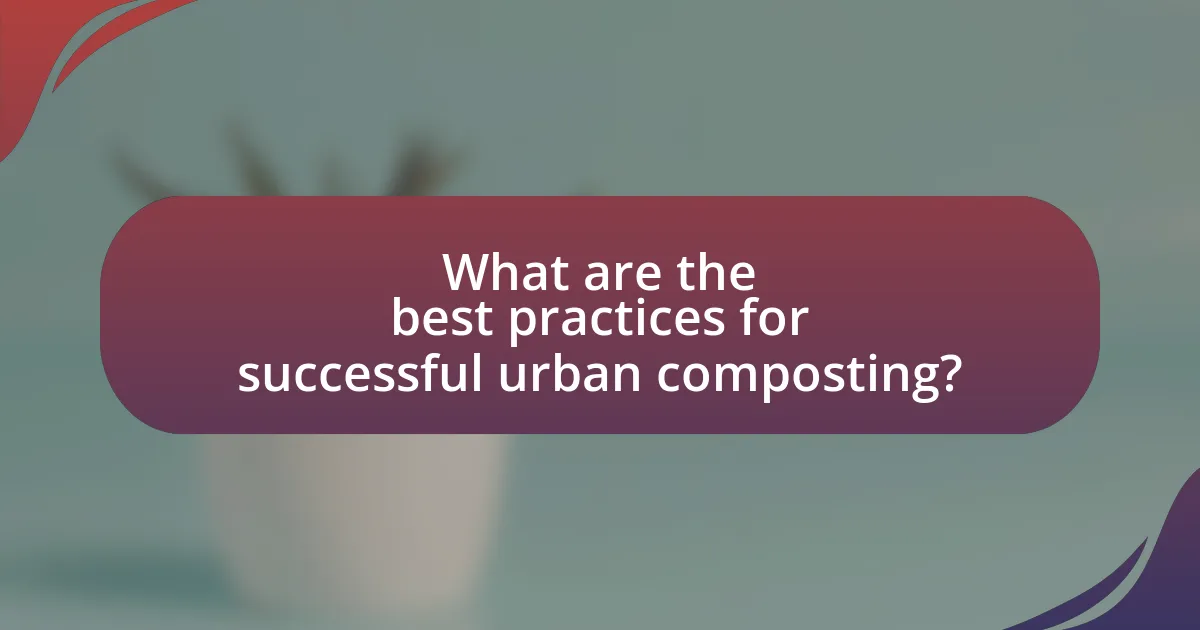
What are the best practices for successful urban composting?
The best practices for successful urban composting include maintaining a balanced mix of green and brown materials, ensuring proper aeration, and monitoring moisture levels. A balanced mix typically consists of approximately 50% green materials, such as fruit scraps and grass clippings, and 50% brown materials, like dried leaves and cardboard. Proper aeration can be achieved by turning the compost pile regularly, which helps to speed up decomposition and prevent odors. Additionally, maintaining moisture levels around 40-60% is crucial; compost should feel like a damp sponge, not too wet or dry. These practices are supported by research from the University of California, which emphasizes that a well-managed compost system can reduce waste by up to 30% and produce nutrient-rich soil amendments.
How can community gardeners effectively manage their compost piles?
Community gardeners can effectively manage their compost piles by maintaining a balanced mix of green and brown materials, ensuring proper aeration, and monitoring moisture levels. A balanced mix typically consists of approximately 30 parts carbon-rich materials (browns) like dried leaves and straw to 1 part nitrogen-rich materials (greens) such as vegetable scraps and grass clippings. Proper aeration can be achieved by turning the compost pile every few weeks, which helps to speed up decomposition and prevent odors. Additionally, maintaining moisture levels around 40-60% is crucial; the compost should feel like a damp sponge, which facilitates microbial activity essential for breaking down organic matter. These practices are supported by research from the University of California’s Agriculture and Natural Resources, which emphasizes the importance of these factors in successful composting.
What are the ideal carbon-to-nitrogen ratios for urban composting?
The ideal carbon-to-nitrogen ratio for urban composting is typically between 25:1 and 30:1. This ratio ensures optimal microbial activity, which is essential for effective decomposition. Research indicates that maintaining this balance allows for efficient composting processes, as carbon provides energy for microbes while nitrogen supplies the necessary nutrients. Studies have shown that deviations from this range can lead to slower decomposition or unpleasant odors, confirming the importance of adhering to these ratios for successful urban composting.
How often should compost be turned or aerated?
Compost should be turned or aerated every 1 to 2 weeks to maintain optimal conditions for decomposition. Regular turning introduces oxygen, which is essential for aerobic microorganisms that break down organic matter efficiently. Research indicates that frequent aeration can speed up the composting process, reducing the time it takes for materials to decompose significantly, often from several months to just a few weeks.
What common mistakes should community gardeners avoid in urban composting?
Community gardeners should avoid several common mistakes in urban composting, including improper material selection, inadequate aeration, and neglecting moisture levels. Using non-compostable materials, such as meat and dairy, can attract pests and create odors, while failing to aerate the compost pile can lead to anaerobic conditions that slow down decomposition. Additionally, maintaining the right moisture balance is crucial; too much moisture can cause the compost to become soggy and smelly, while too little can hinder microbial activity. These practices are essential for creating effective compost that enriches soil and supports plant growth.
How can improper composting lead to odors and pests?
Improper composting can lead to odors and pests due to inadequate aeration and an imbalance of materials. When compost lacks sufficient oxygen, anaerobic bacteria thrive, producing foul-smelling gases like hydrogen sulfide. Additionally, an excess of nitrogen-rich materials, such as food scraps, without enough carbon-rich materials, can create a wet environment that attracts pests like fruit flies and rodents. Research indicates that maintaining a proper carbon-to-nitrogen ratio (ideally around 30:1) and ensuring regular turning of the compost pile can mitigate these issues, promoting aerobic decomposition and reducing odors and pest attraction.
What signs indicate that compost is not breaking down properly?
Signs that indicate compost is not breaking down properly include a foul odor, presence of large, undecomposed materials, and a dry or overly wet texture. A foul odor suggests anaerobic conditions, which hinder decomposition. Large, undecomposed materials indicate insufficient microbial activity or lack of proper mixing. A dry texture can result from inadequate moisture, while an overly wet texture may lead to compaction and poor aeration, both of which impede the composting process.
What practical tips can enhance urban composting efforts?
To enhance urban composting efforts, community gardeners should focus on maintaining a balanced mix of green and brown materials. Green materials, such as vegetable scraps and grass clippings, provide nitrogen, while brown materials, like dried leaves and cardboard, supply carbon. This balance is crucial for effective decomposition, as research indicates that a ratio of approximately 30:1 carbon to nitrogen optimizes composting efficiency. Additionally, turning the compost regularly aerates the pile, promoting faster breakdown and reducing odors. Monitoring moisture levels is also essential; compost should be kept damp but not soggy, as excessive moisture can lead to anaerobic conditions that hinder decomposition. Implementing these practices can significantly improve the success of urban composting initiatives.
How can community gardeners utilize kitchen scraps effectively?
Community gardeners can effectively utilize kitchen scraps by composting them to enrich soil fertility. Composting kitchen scraps, such as vegetable peels, fruit cores, and coffee grounds, creates nutrient-rich organic matter that improves soil structure and promotes healthy plant growth. According to the U.S. Environmental Protection Agency, composting can reduce waste sent to landfills by 30%, while also providing a sustainable way to recycle nutrients back into the garden. By incorporating kitchen scraps into compost bins or piles, community gardeners can enhance their gardening practices and contribute to environmental sustainability.
What resources are available for community gardeners to learn more about urban composting?
Community gardeners can access various resources to learn about urban composting, including local extension services, online courses, and community workshops. Local extension services, such as those provided by universities, often offer free or low-cost educational materials and hands-on training sessions focused on composting techniques. Online platforms like Coursera and Udemy feature courses specifically on composting, allowing gardeners to learn at their own pace. Additionally, organizations like the Composting Council and local gardening clubs frequently host workshops and provide guides that cover best practices for urban composting. These resources collectively enhance knowledge and skills in effective composting methods tailored for urban environments.
